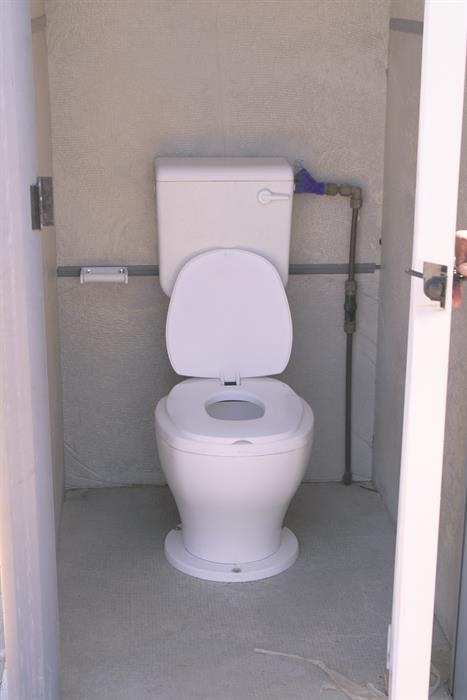Advertorial
BUSINESS NEWS - Residents from the Buffelsdrift settlement in Oudtshoorn received new toilets from the Oudtshoorn Municipality on Wednesday 19 November during a special ceremony.
Western Cape Provincial Head, Zanele Bila-Mupariwa, conducted a walkabout in Buffelsdrift, where newly constructed conservancy tank toilet facilities have recently been completed.
The visit formed part of ongoing efforts to monitor sanitation improvements and ensure that communities have access to reliable, safe and sustainable sanitation services.
Following the site inspection, Bila-Mupariwa addressed residents gathered at the Rosevalley Library, where she commended Oudtshoorn Municipality for its impressive progress in delivering sanitation services.
"The Oudtshoorn Municipality continues to perform exceptionally well within the province and nationally. With 93.7% of households having access to sanitation and only a 6.3% backlog remaining, this work is truly commendable," she said. She also emphasised the importance of ongoing investment and collaboration to strengthen sanitation service delivery and ensure long-term reliability.
Bila-Mupariwa encouraged communities to take pride in their infrastructure and guard it against vandalism and misuse.
"As we celebrate this important day, I want to remind everyone that while the government must provide dignified sanitation, the sustainability of these services depends on all of us. We must protect toilets, taps, sewer pump stations and all water infrastructure from damage."
To reinforce hygiene awareness, the department distributed soap and toilet paper to attendees as a reminder of the importance of healthy sanitation practices and the responsible use of toilet facilities.

World Toilet Day is celebrated on 19 November to raise awareness about the global sanitation crisis and to highlight the importance of safe, accessible toilets for all, and is celebrated by the United Nations General Assembly, and is co-ordinated every year by a partnership between UN-Water and governments around the world.
World Toilet Day celebrates the importance of toilets and raises awareness of the 3.5 billion people still living without safely managed sanitation. Taking action to tackle the global water and sanitation crisis, which has a profound impact on public health, education, gender equity and persistent inequalities.

Sustainable sanitation and climate change
World Toilet Day seeks to inspire action to tackle the global sanitation crisis and help achieve Sustainable Development Goal No 6 (commonly known as SDG 6), which promises sanitation for all by 2030. It draws the world's attention to sanitation issues all over the world and educates the public on the effects that a lack of sanitation has.
This year, World Toilet Day focused on "Sustainable Sanitation and climate change".
The effects of climate change are evident. Floods, drought and rising sea levels are threatening sanitation systems, from toilets to septic tanks and treatment plants. Everyone must have sustainable sanitation with handwashing facilities alongside clean water to help protect and maintain health security and stop the spread of deadly infectious diseases such as cholera, typhoid, as well as Covid-19.
Sustainable sanitation systems must also explore the reuse of waste water and waste to safely boost agriculture, reduce and capture emissions for greener energy. Sustainable sanitation is about human excreta that is safely managed across the whole value chain. It begins with the humble toilet that effectively captures human waste in a safe, accessible and dignified setting.
The waste then gets stored in a tank or pit, which can be emptied later by a collection service, or transported away by pipework (sewer network). The next stage is treatment and safe disposal. Safe reuse of human waste helps save water, reduces and captures greenhouse gas emissions for energy production and can provide the agricultural sector with a reliable source of water and fertiliser and by products filled with nutrients.
Toilet facilities in South Africa
In South Africa, significant progress has been made in addressing the sanitation backlog and providing appropriate sanitation to poor households in the country since 1994. According to the STATS SA General Households Survey 2019 report, nationally, the percentage of households with access to improved sanitation increased from 61.7% in 2002 to 83.0% in 2018. Currently, 17.0% of households do not have access to a basic level of sanitation and it is the Sustainable Development Goal that all households should be served or have access to sanitation by 2030.

How do toilets protect our health?
More than two in five people globally lack access to a decent toilet in their home, often relying on inadequate facilities or practising open defecation. Climate change is now worsening this crisis by straining sanitation infrastructure and services. When untreated human waste gets out into the environment, it can spread deadly and chronic diseases. Sustainable sanitation systems, combined with the facilities and knowledge to practise good hygiene, are a strong defence against current and future public health threats.
What does a sustainable sanitation system look like?
Sustainable sanitation begins with a toilet that effectively captures human waste in a safe, accessible and dignified setting.
‘We bring you the latest Garden Route, Hessequa, Karoo news’
















